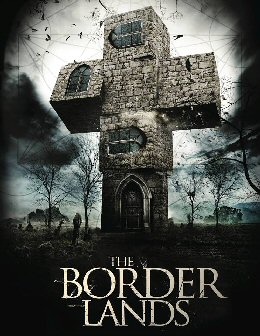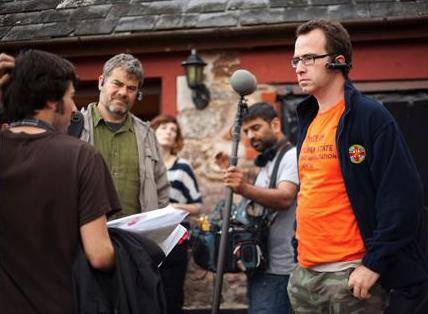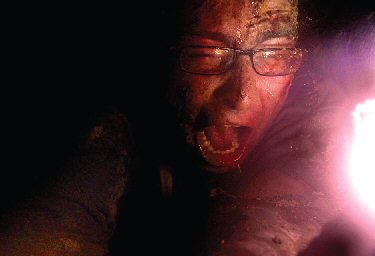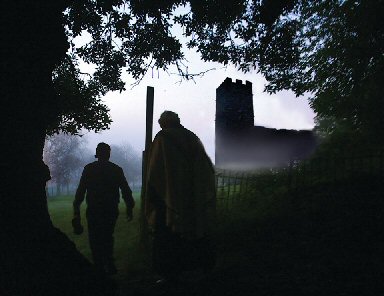With the release of THE BORDERLANDS we welcome another rising talent in the UK filmmaking scene with writer/director Elliot Goldner shining with his debut feature. To celebrate the UK DVD release by Metrodome, our very own Stuart Willis caught up with Elliot to discuss his work…

Stuart: Hi Elliot, I'd like to begin by thanking you for allowing us the opportunity to chat with you, and congratulating you on your extremely entertaining film.
Elliot: Thanks!
Stuart: Can I ask what your background is, and what led to you making "The Borderlands"?
Elliot: After I left film school I worked in and around commercials, music videos and telly, starting as a runner (working for the very eccentric Tony Kaye). These days I divide my time between directing and editing. But making a feature was always a goal and so with The Borderlands finally the stars came into alignment.
Stuart: When I first read a synopsis for "The Borderlands" I did admittedly fear the worst. Mentions of point-of-view camerawork and people investigating paranormal activity instantly set alarm bells ringing. But I was wrong; you took a potentially tired concept and breathed fresh life into it. How did you set about distinguishing your film from others with similar premises?
Elliot: Haha yes it’s a stigma we have to overcome. Because you’re right, when I hear the words found footage I immediately think of a young documentary crew stranded in a forest at night screaming swear words as they get picked off one by one. So at the inception of this project I watched a lot of found footage films, to learn from the good ones (and there are good ones) but at the same time to draw up a list of the cardinal sins of the genre. Lack of script and leaning heavily on improvisation from inexperienced actors is a typical bugbear. And the other big one is the point during most of these films where you think, "Why are you still standing there filming? Stop framing up on that monster and RUN!"
So it was an initial challenge but I was adamant that there should be a valid reason why the characters are filming everything. I just didn’t want that nagging question hanging over the film the whole time you’re watching it. And a lot of time was spent developing the script before we went into production – I think I must have sent five full treatments over to Metrodome before they said okay, have a go at the script. In actual fact the finished script didn’t read like a found footage film and various people, when they came on board to the project said to me, "You know, you don’t have to shoot this as found footage." I think they meant that the story stood up on its own. Almost implying that found footage films are shot that way because they don’t have enough story to work as ‘normal’ films.
But by that point I was committed. Found footage is quite a forgiving genre to shoot – you can get away with shaky shots and all that. So while that was an obvious incentive when making a film with very little money, it was actually for purer reasons that I stuck with the style. I realised that the whole story is about whether one should believe what is happening before their eyes. Found footage adds a level of purity, veracity to it. We couldn’t have someone saying "No the place is empty" and then track backwards to reveal a snarling demon waiting for them behind the door, or other tricks that arise from the using an ‘omnipotent camera’. We couldn’t have a scene where one of the characters kills everyone and then we reveal we were inside their head and it was just a fantasy sequence. The idea of found footage actually became integral to the film. As we’re constantly asking the audience to decide whether or not what they’re seeing is real, with found-footage we’re at least able to lay out some basic ground rules. I think the scene that sums this up the most succinctly is the one right in the middle with the practical magic trick, which is performed right in front of our eyes.
Stuart: Is it difficult getting funding in the current climate? What was your personal experience of raising funds for your film?
Elliot: I was very fortunate to be approached by Metrodome, who up to this point have been a UK distributor. They were looking at getting into production and I think they put out some feelers for people who might like to develop projects, I was asked to have a go at developing a low budget horror. It was all essentially done on spec at this point but still it was a great position to be in because if they liked it then the funding was there and I’d get to direct. That was enough incentive! There was less freedom than if I had been doing it all myself of course but sometimes a few restrictions are just what you need to be creative. It was a bit like working for a small studio, or maybe a TV commissioner: sometimes it was a battle but then again it’s probably a much better situation than having total freedom, funding and shooting your film and then struggling to find anyone to distribute it.

Stuart: "The Borderlands" benefits from terrific casting. Could you speak a little about the principal players?
Elliot: Casting was interesting (and difficult). For the found-footage to seem plausible the acting needs to have qualities of spontaneous speech, so I knew from the off that I wanted to incorporate improvisation. But there’s also a lot of scripted exposition that needs to come across, so I couldn’t let the improv take us too far off track. We needed to find actors happy moving between scripted material and improv. Rob was the first person we cast, a great ‘curveball’ suggestion as although he can really act, he’s not really an actor; he actually has a very successful career as an editor. But I’d watched him in Down Terrace and knew he’d be great in the role. He added a real bite to the character.
So the challenge then was finding someone to pit up against Rob. We screen tested a few guys with him and it wasn’t working, Rob’s naturalistic and spontaneous style really threw some people. Then we had a casting and Gordon Kennedy came along. I remember seeing his face on the casting sheet and thinking, "Oh wow, Stoneybridge!" (a sketch from a C4 TV show called Absolutely that I used to love). But also thinking, shame because we need someone with suitable world-weary gravitas, not a comedy guy. But Gordon blew us away at the casting – he read the scene from the pub about the girl with stigmata and just left Jen (the producer) and I breathless. So he had the chops and can really turn on the nuanced, emotive performances when you need it but I think his comedy background turned out to be invaluable – not because we required too many laughs from Deacon’s performance but he could really think on his feet and worked as the perfect foil to Rob’s non-sequiturs. Plus he was such a great person to have on set, an untiring team player, keeping the crew happy and laughing.
To be honest they were both a great deal of fun to work with. To the point where I got worried a few days in that I was making a comedy rather than a horror. When Aidan (who plays Father Mark) arrived on set he started picking up on the vibe and dropping in these little comic asides which had me cracking up. He’s a really naturally funny guy too, I’d love to cast him in a comedy – but it was bad because I found myself having to take him aside and say, look, I love what you’re doing but please don’t do it. Although maybe making him hold back and play the straight man introduced a kind of pent-up energy that worked out perfect for his character.
Stuart: If there's one character in your screenplay that most resembles you, which one is it and in what ways?
Elliot: After the first draft I realised that Gray’s character needed to function as the audience’s way in to the film. If it had been three guys from the Vatican there would have been all this inside talk and jargon that would have made it impenetrable to the average viewer. So having a character who’s a newbie in a situation asking questions gives you the opportunity to explain things to them (and therefore to the audience to). I’ve not spent my life immersed in Catholicism so from the off, Gray’s background resembles mine the most. But he’s a very open-minded character, quick to believe, more so than me. I initially based his open-mindedness on a friend of mine who is bang into his conspiracy theories and aliens – so I’m probably more like the other two in that I tend to take a sceptical, empirical approach to most things, religion included.
Stuart: In my review I've likened the early, more comedic scenes of "The Borderlands" to "Father Ted" and "Peep Show". Is there any accuracy to those comparisons?
Elliot: I’d say that’s fair – and also very flattering because those two shows are among the best comedy that these isles have ever produced. The funny thing is though when we started working on the look I tried everything in my power to make it not resemble Peep Show. I’ve always been a total cinematography nerd and I always saw my first feature as something that would be a visual feast. And that’s not to denigrate Eben’s work on this by the way – he did an amazing job. But we tested lenses and cameras at the beginning and as beautiful as a low depth of field and artfully-lit film would have been, it wouldn’t have been right for the story. I felt bad for Eben because naturally his initial inclination was to use the best lenses and make it look all photographed and I was forcing him to make it look un-cinematic. It needed to look real.
That’s not to say that I don’t think it looks great. Actually a ref that Eben and I worked from was the Gaspar Noe film Enter The Void, which has some virtuoso point of view photography. But you know, that was shot in a neon-drenched Tokyo, we were in the overcast UK. And so I did have these periodic panics where I thought ‘Oh no, it looks just like Peep Show’, e.g. felt a bit TV. It was about the time when I was fretting about accidentally making a comedy instead of a horror film so that association didn’t help. But I started to embrace it because I realised that it was a strange hybrid that hopefully doesn’t look anything like anything else out there. We really started getting into incorporating characters actions into the shot. A shot from the headcam in the cottage is pretty boring just on a wide angle lens, but as soon as you see a hand or a leg it comes to life. If the character is making a cup of tea or grabbing a beer from the fridge while they’re talking it’s voyeuristically fascinating. You’re seeing angles that are on the one hand totally everyday, except that they’re the kind of details superfluous to the plot you’d never bother to shoot in a normal film. It involved the actors getting very close and personal with the DOP and a lot of behind the camera choreography but I think it paid off.
And as for Father Ted, I remember the first discussion I had with Jon our costume guy trying to make sure they weren’t all wearing black shirts and dog-collars. Again, I love Father Ted and I’m sure its influences have subliminally made their way into my work but anything involving priests that want to be taken even remotely seriously needs to take some cursory steps to distance itself from Father Ted.
Stuart:...And the way the tone shifts into darker territory brought to mind the cinema of Ben Wheatley. Are you a fan of Ben's work?
Elliot: I really like what Ben Wheatley is doing to the UK film industry. His stuff is leftfield, oddball, weird, upsetting – a real anathema to the kind of well-meaning films that we manage to churn out. So I hope that he’s at the spearhead of a movement proving that there’s a market out there for more unusual and uncatergorisable films. His are the type of films that funding bodies would typically have avoided, I guess branding them entertainment, instead plumping all their money into some beautifully shot rites of passage story that is commercial suicide and quite boring. You can’t ever say that his films are boring. I love his sense of humour, although he doesn’t half like a bit of the old ultra-violence, does he?
Rob (who plays Gray) edited a number Ben’s films including Kill List and Down Terrace and the sound design was by Martin Pavey who also did a cracking job on A Field in England.

Stuart: The religious aspect is an interesting twist to your screenplay. How much of this is based on research? Is there any truth to any of what we're watching?
Elliot: It’s all true – partially. There really is a branch of the Holy See called The Congregation for the Causes of Saints who go out and investigate purported miracles. And they really do investigate with a scientific zeal. Because there’s the paradox that for something to be officially miraculous, it needs to be scientifically impossible and in order to prove that you need to explore all the rational explanations. Luckily for us their work is shrouded in secrecy allowing for a certain amount of artistic licence.
But it’s definitely a real thing and something I realised when writing this, that’s the main schism between Roman Catholicism and CoE is that the CoE don’t believe in miracles. Or they do for the old ones, like the ones that Jesus performed back in the day but they don’t go more modern-day miracles and worship saints, whereas the Catholic church is still all about this magic and miracle. And I found that a fascinating subject to explore, the way an organisation like that operates in the modern age.
Stuart: The shoot was clearly made on location, as opposed to studio sets etc. I like that; it adds a raw immediacy to proceedings. But did this present problems for you and your crew?
Elliot: Yes and no. Because of the style of shooting, which involved long takes taking in 360 degrees angle of view, creating sets would have been a bit of a nightmare. And anyway, the amount of detail that you can get in a real location versus a set, certainly at this budgetary level meant the church was always going to be a location. I’ve always preferred the look of films shot on location, I mean think of Robocop, which has an amazing grubby and lived-in milieu compared to Total Recall which just feels fake to me, too clean.
It meant it would also have been very difficult to put lights anywhere as you end up seeing the stands. On a big production you would get a balloon light in or something. On this we made the decision not to light it so that made life a little easier, but yeah it was still pretty crazy on set, with me, the camera assistant, the sound guy and anyone else involved running around behind the camera or ducking into church pews to avoid getting into shot.
Stuart: And is there significance as to where the film's set? That is, why the borderlands?
Elliot: The spark for the idea came from seeing the church at Brentor in Dartmoor, which is this incredible church on this imposing craggy rock face. There’s something quite magical and mysterious about that part of the world, and although there’s not anything particularly geographically specific about that location it seemed as good a place as any. We were keen to not portray a stereotypical view of the countryside with all yokels and bumpkins – which is why we have the scenes at the beginning where they’re driving through all those housing estates. I wanted to show a contemporary rural reality, which is as much grim industrial estates and kids in hoodies as it is sheepdogs and misty hills.

The borderlands is this strange hinterland between where the town starts and the countryside ends, but it’s also the place between the secular and the religious, between the past and the present.
Stuart: In terms of horror, what stylistic influences did you have going into making the film?
Elliot: Well I don’t want to be accused of just having made an amalgam of several films, but The Wicker Man, Paranormal Activity, The Exorcist were definitely influential. The George A Romero vampire film Martin inspired me in the way it manages to keep the ‘is he, isn’t he?’ thing going throughout.
Stuart: Is the film's concept one that you can imagine exploring any further?
Elliot: Haha, no.
Stuart: How's "The Borderlands" coming across to audiences? Have you been present at any screenings?
Elliot: Yes and it’s a strange and gratifying feeling. Luckily the film has funny moments so when you hear the audience laughing it lets you know they’re still on board. It’s harder to tell how scared people are (apart from during obvious jumps) because they tend to sit in silence. But that’s better than talking I guess. Or jeering and throwing rotten vegetables at you. But it’s afterwards when people have come up to me to tell me how scared they were, that’s really gratifying. When you been living with a film that long it no longer has any effect on you…so to have a real hardcore horror fan at Frightfest, Grimm or Mayhem tell you they were shitting themselves, that’s an amazing feeling.
Stuart: Has it been screened overseas yet? I wondered how the humour would translate on different shores, as I'd consider it to be distinctly British?
Elliot: It showed as a ‘British Invasion’ double-feature with A Field in England at Beyond Fest in Los Angeles late last year. I couldn’t make it over but by all accounts it was very well received. I would hope its Britishness would be part of the appeal – I don’t think there’s anything too colloquial for an American viewer to understand, hope not anyway. Would be more interested to see how it goes down in Germany – they were dubbing it into German the other day for the release over there.
Stuart: What's next for you? Do you plan to stick with the genre or branch out into other styles of film?
Elliot: I hope this isn’t the last horror film I ever make but I don’t think my next one will be. I’m currently writing a comedy, which I hopefully won’t seem too much of a leap for anyone who’s watched the film. But I have a strain of darkness that runs through most of my work that always seems to bubble up so you never know; it might turn out to be a horror after all!
Stuart: Thanks again for your time, Elliot, it's greatly appreciated. And good luck with the film!
Special thanks to Elliot Goldner and Metrodome. The Borderlands is now available on DVD.